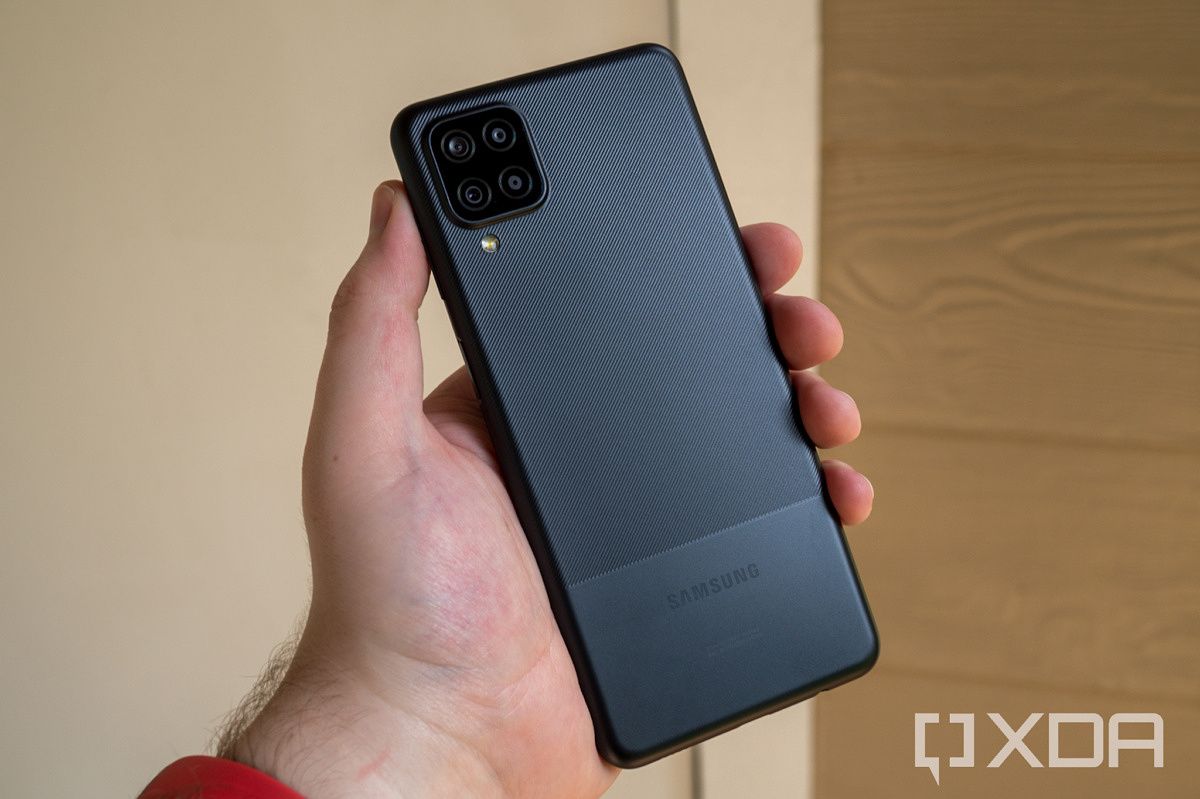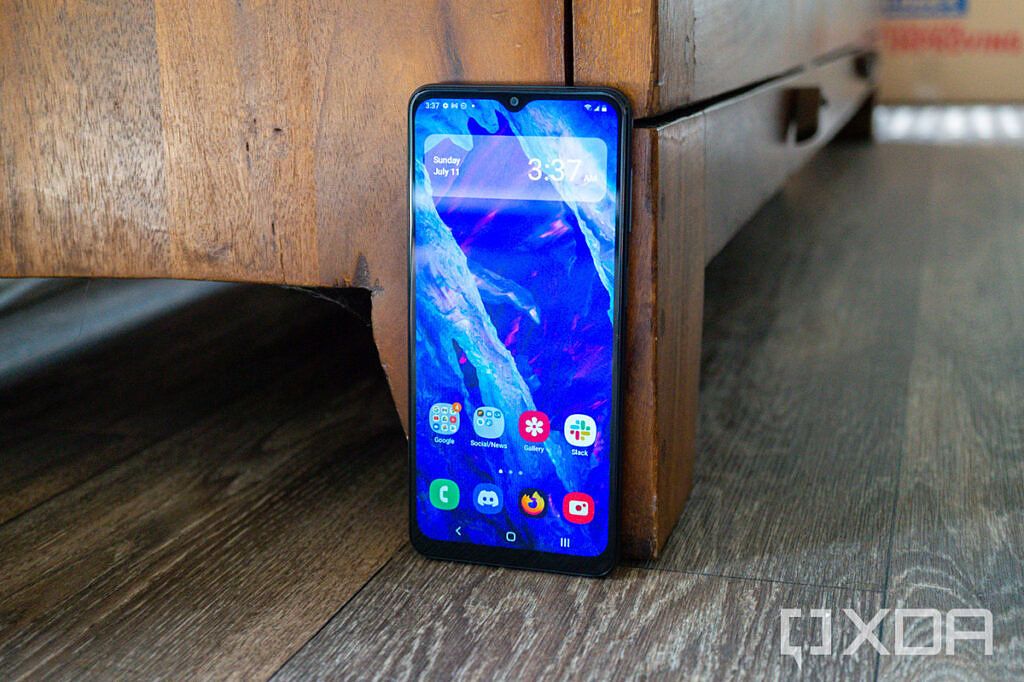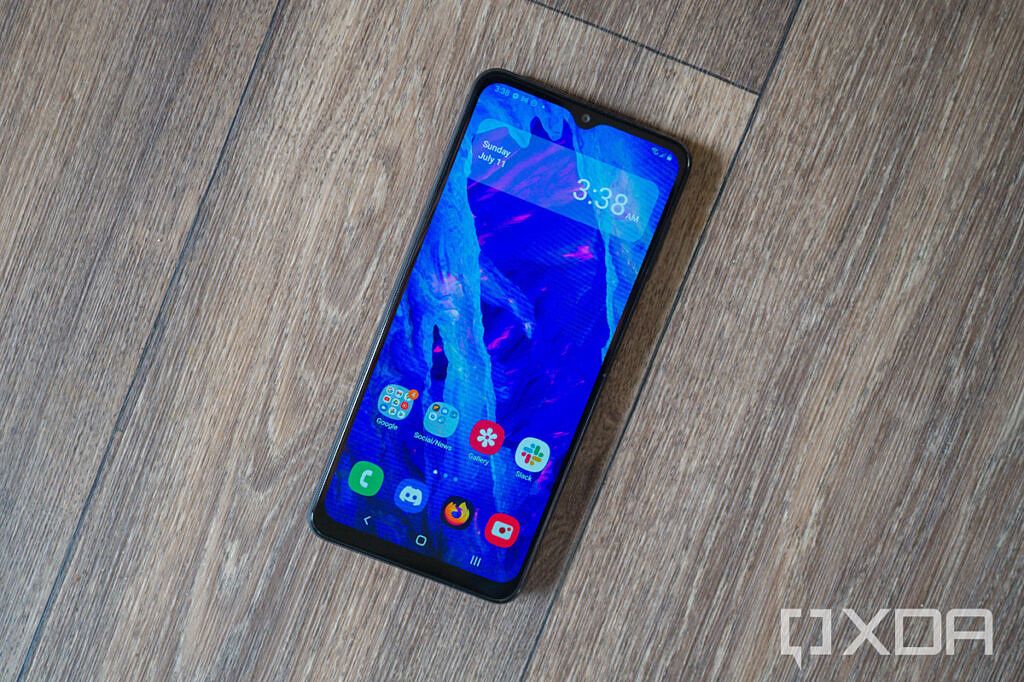Samsung first showed off the Galaxy A12 and Galaxy A02s in November last year, and in the following months, it was gradually released in India and other regions. The phone has been available in the United States for a while now, and since we've had a look at most of Samsung's other US budget phones, we thought now was as good a time as any to give the A12 a shot.
Like the Galaxy A11 that came before it, the Galaxy A12 is a low-end budget phone. It doesn't seem too bad on paper, with a 6.5-inch display and 5,000mAh battery, but it's a frustrating experience in day-to-day use. Our full review is below, but spoiler alert — you should probably buy something else.
Samsung Galaxy A12: Specifications
|
Specification |
Samsung Galaxy A12 |
|---|---|
|
Build |
|
|
Dimensions & Weight |
|
|
Display |
|
|
SoC |
|
|
RAM & Storage |
|
|
Battery & Charging |
|
|
Security |
Side-mounted fingerprint sensor |
|
Rear Cameras |
|
|
Front Camera |
8MP |
|
Ports |
|
|
Audio |
Bottom-facing speaker |
|
Connectivity |
|
|
Software |
Android 10 (One UI Core 2.5) |
About this review: I received the Galaxy A52 5G from Samsung USA, and I’ve used the device for about a week. Samsung was not involved in any part of this review.
Design and Build
The Galaxy A12 is a large plastic slab, measuring 164 mm tall and 75.8 mm wide. It's definitely a large phone, but not too far from the average modern Android phone. The front has a 6.5" IPS screen with a resolution of 1600 x 720. The lower resolution definitely doesn't look great stretched out to 6.5 inches, but there aren't many 1080p phones at this price range (in the US, anyway). Above the display is a notch for the front-facing camera (Samsung calls this design "Infinity-V"), and below the screen is a small bezel.
The sides and rear of the phone are covered in the same plastic material, but the upper back section of the Galaxy A12 has an added texture. I definitely prefer matte plastic over the glossy plastic covering found on many other budget phones (such as Samsung's own Galaxy A42), so I don't have any complaints here. It's still plastic, but it's plastic that won't easily become covered in fingerprints and smudges.
On the left side of the phone is the microSD and SIM card slot. The Galaxy A12 supports SD cards up to 1TB in size, but keep in mind Samsung turns off Android's adoptable storage feature on all its phones, so you can only use SD cards for storing files — not apps. Moving to the right side, you get volume controls and a fingerprint sensor that doubles as the power button. The sensor has no problems quickly detecting my finger, but it's hard to reach if you're holding the Galaxy A12 in your left hand.
Finally, the bottom of the phone has a USB Type-C connector, a 3.5mm headphone jack, and a single speaker. The speaker sounds terrible, as you'd probably expect on a budget phone. You can charge the Galaxy A12 over USB Type-C at up to 15W, and Samsung includes a 15W wall adapter in the box.
Software
If you've used any Samsung phones recently, the Galaxy A12's software won't surprise you. It's nearly identical to the One UI experience you get on Samsung's other devices, though the Galaxy A12 is one of several devices with the slightly stripped-down 'One UI Core' experience.
One UI Core doesn't support Good Lock, Bixby (including Bixby Routines), Samsung Pay, and Secure Folder. The app mirroring functionality in Microsoft's Your Phone app also isn't available, but you can still check notifications on a Windows 10 PC. You can't use the Samsung DeX desktop environment either, but that also goes for many devices running standard One UI — it needs more processing power than the Galaxy A12 has to give.
Most of the features people look for on Samsung phones are still here, though. You can switch between light and dark themes (including an automatic mode), open apps in small floating windows, and more. However, even though Android 12 is only a few months away, the Galaxy A12 is still running Android 10. Samsung has started rolling out Android 11 for the Galaxy A12 in some countries, but the update hasn't reached America yet.
It's also important to note that Samsung’s promise of three generations of Android upgrades does not currently include the A1x series, so there's no guarantee for how many OS updates the Galaxy A12 will get. Samsung just started rolling out Android 11 to last year's A11, and the A10 before that only received one update to Android 10, so it seems likely that Android 11 will be the Galaxy A12's only major update.
Performance and Battery Life
Oh boy. I know this is a $180 phone (which frequently goes on sale for around $100), so I have to keep my expectations in check, but the Galaxy A12 is not fun to use. Most apps open within a few seconds, but there's so much latency with animations and scrolling that the phone is frustrating to use most of the time. Even the default keyboard was missing some of my key presses due to lag — switching to Gboard is an improvement. Bottom-of-the-barrel performance isn't unusual in this price bracket, but that doesn't make the experience any less tiresome.
I've spent the past few months going down the ladder of Samsung's current budget phones, starting with the Galaxy A52 5G, and moving down to the Galaxy A42 5G and Galaxy A32 5G. The Galaxy A12 is cheaper than all those phones, so slower performance is to be expected, but the Galaxy A32 (which retails for $280, but is on sale right now for $205) is a significantly better experience than the Galaxy A12. The phone's MediaTek Helio P35 chipset and 3GB RAM just can't keep up.
Battery life, at least, is perfectly acceptable. The large 5,000mAh battery should last for around two days of normal usage for most people. So if you charge your phone every night, you'll likely never drop below 40-30%.
Camera
The Galaxy A12 has four rear cameras, but only three of them can be used to capture photos: the 48MP main lens (which combines pixels down to 16MP), a 5MP ultra-wide, and a 2MP macro. The last camera is a 2MP depth sensor, which is supposed to help the other lenses. Finally, there's an 8MP camera on the front for selfies.
The story here is mostly the same as other budget phones — if you have plenty of natural light, you can take decent photos with the main camera. The above photos of the bushes and building look good for a ~$170 smartphone, though the phone struggled more with indoor photos, even when there was plenty of natural light coming through the windows.
The ultra-wide camera's limited resolution of 5MP produces photos that look significantly worse than the main lens, and the same goes for the 2MP macro lens. They're passable for the occasional Snapchat or Instagram story, but that's about it.
Conclusion
The Galaxy A12 is one of the cheapest smartphones currently sold by Samsung, so it's probably not much of a surprise that the phone isn't wildly fast. However, the phone is incredibly frustrating to use, even by the standard of other budget smartphones. When the keyboard is lagging during the initial setup process, you know you're in for trouble.
This phone has a suggested retail price of $179.99 in the United States, which is absolutely too much money for a phone that struggles with basic tasks. Samsung and most carriers are currently selling it for $104.99, which is better, but still doesn't fix the Galaxy A12's performance issues. You're also still going to be stuck with Android 11 as the final update... whenever that arrives.
I would strongly recommend buying a Galaxy A32 5G instead if you can afford it, which normally costs $279.99 but frequently goes on sale for $205. Buying a used iPhone 8 or iPhone X is another solid option in this price range — battery life likely won't be as good, but you could replace the battery later on, and even these old iPhones are substantially faster than the Galaxy A12. They should also have a few iOS updates left since iOS 15 still supports devices as old as the iPhone 6S.

Samsung Galaxy A12
This budget phone might have a big display and long battery life, but performance is a constant problem.



